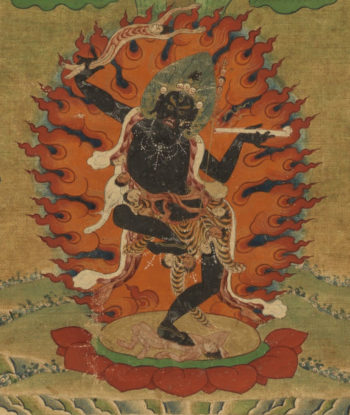The Yeti is a cryptozoological phenomenon popularized in the early 20th century by British mountain explorers in the Himalayas. Those who claim to have seen it report a modest-sized, two-legged, hairy mountain creature with disproportionately large feet.

A recent scientific study has shown, once and for all, that physical evidence (fur, bone and skin) purported to be from the Yeti are instead from bears, based on genetic analysis. Bear species that fall within the “range” of the Yeti include Asiatic black bear and two subspecies of brown bears, the Tibetan and Himalayan.
The reports of Yeti sightings began as soon as Western explorers made headway into the Himalayas. The explorers gathered first-hand accounts from locals and translated these observations into prosaic descriptions of the creature’s shape, fur color and gait.

With this, the Western world began to believe that the Yeti could be real, and Yeti-finding expeditions were dispatched.
Over the decades, Yeti encounters continued to accumulate, though physical evidence has always been elusive.
Nonetheless, the existence of the Yeti could never be ruled out. The Himalayan wilderness seemed vast and inaccessible enough for the existence of an undiscovered animal to be plausible.
In his book The Snow Leopard, famed nature writer Peter Matthiessen writes about a 1973 Himalayan expedition to study the blue sheep. Throughout his narrative, the author seems just as primed to spy a Yeti as he is a snow leopard. And we read that his companion, legendary wildlife biologist George Schaller, also refuses to rule out the Yeti’s existence.

Of all mythical beasts, the Yeti has received the most attention in actual peer-reviewed scientific journals. It has been the subject of articles in such top-tier science and conservation publications as Oryx, Proceedings of the Royal Society B and Molecular Phylogenetics and Evolution.
The Oryx article, published in 1973, summarized the state of knowledge regarding the Yeti’s existence and proposed that it could be an undiscovered human-like hominid that occupied dense unexplored forest on the lower slopes of the mountains.
Become a Member
Make a lasting impact for nature when you join The Nature Conservancy.
All subsequent articles have focused on genetic analysis of purported physical Yeti specimens of hair, bone and skin.
Two recent studies, both published in the Proceedings of the Royal Society B, may finally mark an end to this attention from the scientific community. A 2014 paper concluded that all genetic evidence analyzed from purported Yeti specimens actually came from a wide range of known animals.
The 2017 paper examined a refined set of specimens and found that all but one came from bears (the outlier came from a dog).
The authors conclude with finality that “the biological basis of the Yeti legend is local brown and black bears.”
Lost in Translation

But to conclude that the Yeti isn’t “real” may perpetuate a misunderstanding that began when Western and Eastern cultures met on the slopes of the Himalayas.
We may think of the Yeti as something of a cryptozoological hoax on par with the Loch Ness Monster.
But something about the Yeti, long present in the lore of local cultures, may have been lost in translation.
It may be that these Western strangers far from home may have simply suffered a failure of imagination and did not fully grasp the cultural context of the Yeti myth.
The major religions of the Himalayan region are polytheistic and inclusive, absorbing older folk beliefs and deities as time goes on. This yields a complex spiritual world full of magical beings and places that are in constant interaction with the landscape and affairs of people.
This perspective encompasses old gods and new gods, mountain spirits and river demons.
The purview of a deity may range from being, say, a goddess of destruction, to such minor responsibilities as guarding over a river crossing or one’s home.

Indeed, according to the traditions of Lepcha people who are indigenous to the Himalayan region, the Yeti is an ape-like glacier spirit that holds influence over the success of hunting trips.
Often, tales of the Yeti hint at something that is beyond reality. It isn’t easy to parse the first-hand reports of the Yeti—it is reported as being seen in the flesh, yet it is also given mythical powers.
For example, according to an account by Ang Tsering Sherpa who recalled a time when his father saw a Yeti, “If the Yeti had seen my father first, my father wouldn’t have been able to walk. The Yeti can make people so they can’t walk. Then he eats them.”
The real and unreal intermingle in a world full of helpful and vengeful spirits.
Among these, the Yeti was plucked from obscurity and cultural context to be scrutinized as a creature that literally walks the Earth.
In retrospect, perhaps one of the most remarkable aspects of the Yeti legend is that Western science took on its potential existence as a hypothesis to test.
Is the Yeti real?
I imagine that with a certain world view, one could easily accept both answers to this question.
New Findings and Insights
Fortunately, the latest peer-reviewed study of Yetis did not merely debunk the beast. It left us with fascinating new findings about the genetics of bears and an important conservation message.

This is that the Himalayan brown bear isn’t just another bear. It is a unique creature of an ancient lineage that is in critical need of scientific and conservation attention.
Let’s hope the Himalayan brown bear gains much from its association with the Yeti.
In the end, the Yeti may be now what it has always been: a part of the mythology and folklore of its home.

When thinking of the Yeti, I am reminded of Neil Gaiman’s novel American Gods, in which deities from all the world’s religions vie for bandwidth in the human consciousness. The triumphant ones are those who hold the attention of humanity.
The Yeti is an example of a minor deity from a place remote to the Western world that has indeed captured our attention.
This “glacier spirit, god of hunting and lord of all forest beasts” is now renowned across the globe.
The Himalayas are a captivating place, thanks to both its culture and ecology. So, let’s hold on to both myth and reality: long live the Yeti, and long live the Himalayan brown bear.




I think some people are missing the point. It is ‘real’ in the sense that it’s based on a real creature – the Himalayan Brown Bear. But it’s more of a ‘bear-spirit’ than the real animal. As the article says, it’s a cultural thing not a zoological one. As to the Lepcha’s ape-like creature I wonder if that could be a race-memory of orang-utans, which did once inhabit the foothills of the Himalaya; or the langur monkey.
I agree with elizabeth
the yeti is maybe real. im not sure but this looks legit.
I think ‘yeti’ is not real because if he was real he would be I think found by now. I think this is why he isn’t real. When saw some pic he they looked fake and when we find some sighs then we can also find the fingerprints.
I was hiking in the Himalayas with four other people, two Americans, one Nepali, and one Brit, when I spotted something moving in the far distance across the divide on the side of another mountain, maybe two miles away from us. I asked one of the two Americans, who were on a photo safari, if I could use his high-powered lens to get better look. He allowed me to do so. When I looked I saw not one but 9 brown ape-like creatures walking in a scattered line along a path which traversed the side of a mountain. In the lead were three larger ones with two of the smallest ones in close proximity moving along together. About 30 feet behind them were three medium sized ones which were clumped together and sort of tumbling with each other as they moved along. Last, about 20 feet behind the juveniles, was the biggest one. He was also on all fours moving along the path. I described what I saw to the group. Each one took a look. Each of us saw them. Then I asked the owner of lens to take a shot. He told me he would not take a photo because it wasn’t clear. So I asked him I could watch some more.
He handed me the camera with the lens. I watched for another minute or so, and thought of taking a photo without his permission, but was worried to anger the photographer, when, while I was watching, the Nepali threw a rock which landed in the gravel below us. As I was watching the largest one stood up and searched for a second then looked directly at me. Then all of them raced up the trail and disappeared over the edge of the mountain in a matter of seconds.
The largest one’s face was unmistakably ape-like, rounded with flat features. His chest was broad with reddish hair tinged with gold. The group covered in seconds what would take a human maybe 2-3 hours or longer to climb as there was about a 45 degree angle for the side of that mountain. I took the lens from my eyes and looked at the Nepali who smirked at me when I asked him. “Why’d you do that?” He just shrugged his shoulders and laughed.
They definitely exist. But they are so fast and their senses so specified and superior that they have been able to elude us. And I am glad they have been able to do so as we are the most dangerous and cruelest of species on this planet.
Elizabeth, couldn’t agree more!!! Conserving any animal population is to keep Homo sapiens from discovering their populations!
Great piece Joe! Reminded me of a favorite paper:
Lozier, J.D., Aniello, P. and Hickerson, M.J., 2009. Predicting the distribution of Sasquatch in western North America: anything goes with ecological niche modelling. Journal of Biogeography, 36(9), pp.1623-1627. https://goo.gl/Md5efF
Thanks!
“Nice”.
What an interesting article, with terrific photos to match. Thanks very much!